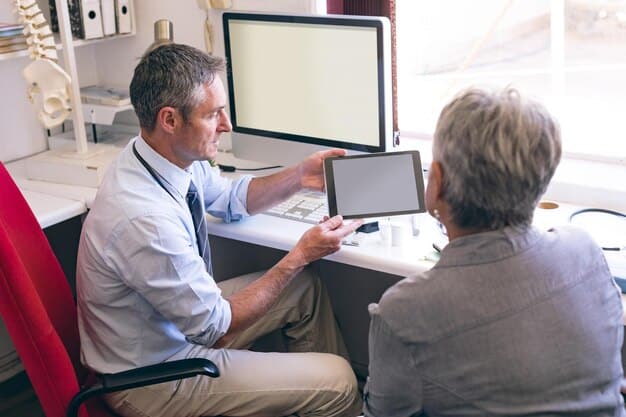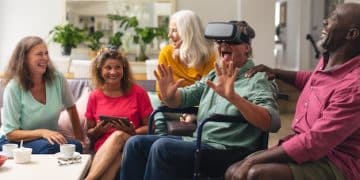How 5G Will Transform US Healthcare in 3 Years

Over the next three years, 5G technology is poised to fundamentally revolutionize US healthcare by enabling seamless connectivity for telemedicine, remote patient monitoring, and AI-driven diagnostics, ultimately enhancing efficiency and accessibility.
The convergence of cutting-edge technology and medical science continually reshapes healthcare delivery. Among these transformative forces, the advent of 5G technology stands out, promising to profoundly alter how US healthcare operates in the next three years. This isn’t merely an incremental upgrade; it’s a foundational shift, paving the way for unprecedented connectivity, speed, and reliability critical for the next generation of medical advancements.
The Foundational Impact of 5G on Healthcare Infrastructure
5G, or the fifth generation of cellular technology, is more than just faster internet; it represents a paradigm shift in connectivity. Its low latency, massive capacity, and enhanced bandwidth are the pillars upon which a truly digital healthcare ecosystem can be built. This infrastructure isn’t just about faster downloads; it’s about enabling real-time critical data exchange, powering remote surgical procedures, and facilitating truly ubiquitous remote patient care.
Unlocking Unprecedented Data Speeds and Capacity
The sheer speed of 5G networks, potentially reaching 10 gigabits per second, far surpasses that of 4G. This unprecedented bandwidth is crucial for transmitting large medical imaging files like MRIs and CT scans almost instantaneously, reducing wait times and accelerating diagnostic processes. Imagine a scenario where a rural physician can upload a high-resolution scan to a specialist hundreds of miles away in seconds, receiving immediate feedback without delay.
- Faster Diagnostics: Rapid transfer of large image files (MRI, CT scans) for quicker analysis.
- Enhanced Collaboration: Seamless sharing of patient data and video consultations among medical teams.
- Real-time Telemedicine: Support for high-definition video calls for remote consultations and evaluations.
Moreover, 5G’s capacity to connect a massive number of devices simultaneously (up to a million devices per square kilometer) transforms the potential for the Internet of Medical Things (IoMT). This capability will allow hospitals and clinics to deploy an extensive network of connected sensors, monitors, and wearables, collecting vital patient data continuously without network congestion. This comprehensive data stream can then be analyzed by AI, leading to proactive interventions and personalized care pathways. The infrastructure backbone of US healthcare will evolve into a smart, interconnected web, where data flows freely and securely, enabling more informed decision-making and efficient resource allocation.
Transforming Telemedicine and Remote Patient Monitoring
Telemedicine has seen rapid adoption, accelerated by recent global health events. However, 5G promises to elevate it from a supplementary service to a primary mode of care delivery, especially in remote or underserved areas. The stability and speed of 5G networks address the previous limitations of choppy connections and delayed data, making virtual consultations as effective as in-person visits.
Enabling Immersive Virtual Consultations
With 5G, teleconsultations can transcend basic video calls. High-definition video with minimal lag makes it possible for specialists to visually assess subtle symptoms, conduct virtual examinations with greater accuracy, and even guide patients or caregivers through complex procedures remotely. This level of detail and responsiveness is vital for critical care situations or for managing chronic conditions where visual cues are paramount.
- High-Fidelity Video: Clearer visual assessments for remote diagnoses.
- Reduced Latency: Near real-time interaction, minimizing communication delays.
- Specialized Tele-Expertise: Access to niche specialists in geographically isolated areas.

Revolutionizing Remote Patient Monitoring (RPM)
Remote Patient Monitoring (RPM) truly comes into its own with 5G. Wearable devices and in-home sensors can continuously collect a vast array of physiological data—heart rate, blood pressure, glucose levels, oxygen saturation—and transmit it securely and instantaneously to healthcare providers. The low latency of 5G ensures that alerts for critical changes are received immediately, allowing for prompt intervention and preventing acute episodes.
This constant stream of data empowers healthcare providers to track patient health trends, adjust treatment plans proactively, and reduce frequent hospital visits, especially for those with chronic diseases like diabetes, heart conditions, or COPD. The consistent, reliable connection provided by 5G minimizes data loss and ensures that care teams always have the most up-to-date picture of a patient’s health status, leading to better outcomes and a significant reduction in healthcare costs associated with readmissions.
Advancing AI-Driven Diagnostics and Personalized Medicine
The synergy between 5G and artificial intelligence (AI) holds immense promise for revolutionizing diagnostics and advancing personalized medicine. 5G provides the necessary pipeline for AI algorithms to access and process massive datasets in real-time, leading to faster, more accurate diagnoses and highly individualized treatment plans.
Powering Real-time AI Analysis of Medical Data
AI algorithms thrive on data, and 5G delivers it at an unprecedented scale and speed. From analyzing complex genomic sequences to interpreting vast quantities of medical images, AI requires high-throughput communication. 5G facilitates this by allowing data from multiple sources—wearables, diagnostic machines, electronic health records—to be aggregated and fed into AI models in real-time. This can lead to instantaneous diagnoses, early disease detection, and predictive analytics that forecast potential health risks based on an individual’s unique biological and lifestyle data.
For example, AI-powered diagnostic tools can analyze radiology scans for subtle anomalies that might be missed by the human eye, offering assistance to radiologists and pathologists. With 5G, these complex analytical tasks can be performed remotely, leveraging cloud-based AI processing power, making specialist diagnostic capabilities accessible globally.
Facilitating Personalized Treatment Plans
The goal of personalized medicine is to tailor medical treatment to each patient’s individual characteristics. This often involves analyzing vast amounts of data, including genetic information, lifestyle choices, and environmental factors. 5G networks enable the secure and rapid transfer of this highly sensitive and voluminous data to centralized AI systems. These systems can then identify patterns and correlations that inform customized drug dosages, therapy selections, and preventative care strategies.
The ability to integrate real-time patient data with historical medical records and global research findings via 5G-enabled AI platforms will allow for dynamic adjustments to treatment plans. This shift from a one-size-fits-all approach to highly customized care promises to improve treatment efficacy, minimize adverse reactions, and ultimately lead to better patient outcomes across various conditions, from cancer treatment to mental health support.
Enhancing Medical Training and Surgical Procedures
5G’s capabilities extend beyond patient care to the realm of medical education and advanced surgical interventions. Its low latency and high bandwidth unlock new possibilities for immersive training programs and enable groundbreaking remote surgical applications, reshaping how medical professionals learn and operate.
Immersive Training with AR/VR
Augmented Reality (AR) and Virtual Reality (VR) are set to revolutionize medical training, offering highly immersive and interactive learning experiences. 5G is the essential enabler for this transformation, providing the bandwidth and low latency required for seamless, high-fidelity AR/VR environments. Medical students can virtually dissect anatomical models, practice complex surgical procedures in simulated environments, or participate in virtual rounds with specialists from around the world.
- Realistic Simulations: VR platforms offering detailed surgical practice without risk.
- Remote Proctoring: Expert surgeons can guide trainees from different locations using AR overlays.
- Anatomical Visualization: AR tools provide real-time overlays of patient anatomy during training.
This hands-on, risk-free training environment can significantly accelerate skill acquisition and improve preparedness for real-world scenarios. With 5G, these sophisticated AR/VR applications can be streamed directly to devices without lag, making them accessible even in remote educational facilities, thus democratizing access to top-tier medical education.
The Rise of Remote-Assisted and Robotic Surgery
Perhaps one of the most astonishing applications of 5G in healthcare is its potential to enable remote-assisted and even fully robotic surgeries. The critically low latency of 5G—down to a few milliseconds—is paramount for such delicate procedures, ensuring that a surgeon’s movements are translated to a robotic arm in near real-time, eliminating dangerous lag.
This capability means that highly specialized surgeons can perform or assist in operations on patients in distant locations, bridging geographical gaps and making expert care available where it otherwise wouldn’t be. Imagine a leading neurosurgeon in a major city guiding a robotic arm for a complex procedure in a rural hospital. While full remote surgery is still in its nascent stages, 5G provides the foundational network stability required to make such groundbreaking medical interventions a reality in the coming years, significantly expanding access to life-saving operations.
Improving Emergency Services and Hospital Management
The capabilities of 5G extend critical support to emergency services and optimize operational efficiencies within hospitals, promising faster response times and more streamlined patient care pathways.
Faster and More Informed Emergency Response
In emergency situations, every second counts. 5G can significantly enhance pre-hospital care and ambulance services by enabling real-time, high-definition communication between paramedics, emergency rooms, and specialists. Ambulances equipped with 5G can transmit vital signs, high-resolution video of the patient, and even ultrasound images to hospital staff while en route. This allows ER teams to prepare for the patient’s arrival, having a clear understanding of their condition beforehand, and potentially initiating treatment plans even before the patient reaches the hospital. This immediate data flow reduces critical decision-making time, leading to better outcomes for critically injured or ill patients.
Moreover, 5G’s robust connectivity can support advanced GPS and mapping for faster navigation, and enable drones to deliver critical medical supplies or even defibrillators to difficult-to-reach locations in urban or rural settings, dramatically cutting response times in life-threatening scenarios.

Optimizing Hospital Operations with Connected Devices
Within hospitals, 5G can transform operational efficiency by creating a truly interconnected environment. IoMT devices, powered by 5G, can track medical equipment, monitor hospital beds, and manage patient flow in real-time. This reduces search times for equipment, ensures optimal bed utilization, and minimizes bottlenecks in emergency departments or operating rooms.
- Asset Tracking: Quickly locate medical equipment like wheelchairs or IV pumps.
- Patient Flow Management: Optimize bed assignments and reduce wait times.
- Smart Inventory: Monitor and automate replenishment of medical supplies.
Beyond asset management, 5G can support complex real-time data analytics for hospital management, identifying inefficiencies, predicting patient surges, and optimizing staffing levels. This level of pervasive connectivity and data insight generated through 5G allows hospitals to operate more smoothly, reduce administrative burdens, and focus more resources on direct patient care, ultimately leading to improved quality of service and reduced operational costs.
Challenges and Ethical Considerations for 5G in US Healthcare
While the transformative potential of 5G in US healthcare is immense, its widespread adoption also brings forth significant challenges and critical ethical considerations that must be addressed for truly beneficial and equitable integration.
Addressing Cybersecurity and Data Privacy Concerns
The massive increase in connected devices and the real-time transmission of highly sensitive patient data via 5G networks inherently escalate cybersecurity risks. Protecting this data from breaches, unauthorized access, and malicious attacks becomes paramount. A single vulnerability could expose millions of patient records or disrupt critical medical services, with severe consequences for patient safety and privacy.
Healthcare providers must invest heavily in robust encryption protocols, advanced threat detection systems, and continuous monitoring to safeguard 5G-enabled medical infrastructure. Furthermore, strict adherence to patient privacy regulations like HIPAA is essential. The ethical imperative to protect patient information must be at the forefront of every 5G deployment strategy, ensuring that trust in digital healthcare remains unshaken. The complexity of securing such a vast and interconnected network requires a multi-layered approach, involving not just technological solutions but also rigorous training for staff and clear protocols for data handling and incident response.
Ensuring Equitable Access and Digital Literacy
The benefits of 5G in healthcare should be accessible to all, but significant disparities in network coverage and digital literacy persist. Rolling out 5G infrastructure, especially in rural and underserved urban areas, requires substantial investment. Without equitable access, the digital divide in healthcare could widen, with urban centers benefiting from advanced 5G-enabled care while remote communities are left behind, exacerbating existing health inequities.
Beyond infrastructure, ensuring that patients and healthcare providers possess the necessary digital literacy to effectively utilize 5G-driven tools is critical. Training programs and accessible user interfaces are vital to bridge this gap. The ethical consideration here lies in advocating for policies and funding that promote universal 5G coverage and digital inclusion, ensuring that technological advancements translate into improved health outcomes for every citizen, regardless of their socioeconomic status or geographic location.
Furthermore, the ethical implications of AI-driven diagnostics and remote surgical tools, while promising, require careful oversight. Questions surrounding accountability in case of AI errors or robotic malfunction, and the potential for algorithmic bias in AI models that could lead to disparate treatment for certain demographic groups, need proactive legal and ethical frameworks. The integration of 5G must be guided by principles that prioritize patient safety, fairness, and transparency, ensuring that technology serves humanity responsibly.
| Key Area | 5G’s Impact in 3 Years |
|---|---|
| 🚀 Telemedicine & RPM | Enables high-definition virtual visits and real-time remote monitoring for chronic conditions. |
| 🧠 AI & Diagnostics | Powers faster analysis of complex medical data for accurate, personalized diagnoses. |
| 🏥 Hospital Efficiency | Optimizes operations through connected devices, asset tracking, and smart inventory. |
| 🛡️ Cybersecurity Challenges | Requires robust security measures for patient data given increased connectivity. |
Frequently Asked Questions About 5G in US Healthcare
5G will enhance telemedicine by providing ultra-reliable, high-bandwidth connections, enabling high-definition video consultations with minimal lag. This allows for clearer visual assessments, real-time sharing of large medical files, and opens the door for immersive AR/VR experiences in remote diagnostics and surgical guidance, making virtual care more comprehensive.
For remote patient monitoring, 5G ensures continuous, real-time transmission of vast amounts of physiological data from wearables and home sensors. Its low latency guarantees immediate alerts for critical changes, enabling proactive interventions and personalized care, significantly reducing the need for frequent in-person hospital visits for chronic disease management.
While full remote surgery is complex, 5G’s extremely low latency (milliseconds) provides the critical foundation for remote-assisted and robotic surgery within three years. Expert surgeons can guide robotic arms in distant locations, bridging geographical barriers to specialized care. This capability will likely begin with supervised or assisted procedures, pushing surgical accessibility.
The primary cybersecurity challenges involve protecting vast amounts of sensitive patient data transmitted over 5G networks from breaches and unauthorized access. Increased connectivity means more potential entry points for attackers. Robust encryption, advanced threat detection, and strict adherence to privacy regulations like HIPAA are essential to mitigate these risks and ensure patient data security.
By enabling advanced telemedicine and remote care, 5G can significantly bridge healthcare disparities, particularly in rural and underserved areas. It brings specialist knowledge and advanced diagnostic capabilities closer to patients, reducing the need for travel. However, equitable infrastructure rollout and digital literacy initiatives are crucial to ensure these benefits reach all communities.
Conclusion: The Dawn of a Connected Healthcare Future
The integration of 5G technology into US healthcare over the next three years is not just an incremental improvement; it is the catalyst for a fundamental transformation. From revolutionizing telemedicine and enabling sophisticated remote patient monitoring to powering AI-driven diagnostics and potentially groundbreaking remote surgical procedures, 5G promises to yield a healthcare system that is more connected, efficient, and accessible than ever before. While challenges related to cybersecurity, infrastructure development, and digital equity must be diligently addressed, the overarching potential to deliver higher-quality, more personalized care to a broader population is undeniable. As we look ahead, 5G will redefine the very fabric of healthcare in the US, laying the groundwork for a future where advanced medical care is truly at one’s fingertips, anytime, anywhere.





